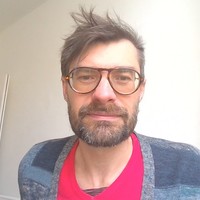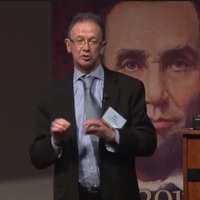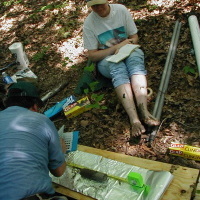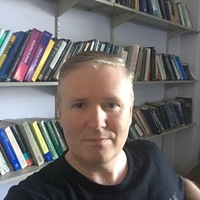
Claus Emmeche
My present research focus is philosophy of interdisciplinarity with friendship studies as a case. This includes questions like "how differently are academic disciplines framing friendship phenomena?", "what are the benefits of interdisciplinary approaches to friendship?", "how can friendship and collegiality affect research collaboration?", and "how can the case of friendship studies deepen the understanding of interdisciplinarity?".
I am an Associate Professor at the Department of Science Education (https://www.ind.ku.dk/english/staff-auto-list/?pure=en%2Fpersons%2Fclaus-emmeche(49247342-931a-4de6-922e-5b3527db7133).html), and director of the Laboratory for the Philosophy of Nature (previously "Center for the Philosophy of Nature and Science Studies", https://web.archive.org/web/20181019212026/http://www.nbi.dk/~natphil/ ), at the Faculty of Science, University of Copenhagen.
I have contributed to the study of living processes as sign processes (biosemiotics, see www.biosemiotics.org), and have interests in the history, philosophy, and social studies of science, and science policy. I organized a Danish group blog on academic freedom (professorvaelde.blogspot.com), claiming universities as public goods in democratic societies, to contest and challenge the increasing dominance of academic capitalist knowledge regimes, and to support academic freedom, free inquiry and higher education as public goods.
Address: Department of Science Education at the University of Copenhagen,
Niels Bohr Bygningen, Universitetsparken 5,
DK-2100 Copenhagen Ø
Denmark
I am an Associate Professor at the Department of Science Education (https://www.ind.ku.dk/english/staff-auto-list/?pure=en%2Fpersons%2Fclaus-emmeche(49247342-931a-4de6-922e-5b3527db7133).html), and director of the Laboratory for the Philosophy of Nature (previously "Center for the Philosophy of Nature and Science Studies", https://web.archive.org/web/20181019212026/http://www.nbi.dk/~natphil/ ), at the Faculty of Science, University of Copenhagen.
I have contributed to the study of living processes as sign processes (biosemiotics, see www.biosemiotics.org), and have interests in the history, philosophy, and social studies of science, and science policy. I organized a Danish group blog on academic freedom (professorvaelde.blogspot.com), claiming universities as public goods in democratic societies, to contest and challenge the increasing dominance of academic capitalist knowledge regimes, and to support academic freedom, free inquiry and higher education as public goods.
Address: Department of Science Education at the University of Copenhagen,
Niels Bohr Bygningen, Universitetsparken 5,
DK-2100 Copenhagen Ø
Denmark
less
Related Authors
Diane Pecorari
University of Leeds
Roberto Kulpa
Edinburgh Napier University
Alfonso Montuori
California Institute of Integral Studies
Kevin Niall Dunbar
University of Maryland
B. Harun Küçük
University of Pennsylvania
Kristen J Gremillion
Ohio State University
Richard Menary
Macquarie University
Dylan Trigg
Central European University
Martin Kusch
University of Vienna
Heather Douglas
Michigan State University
InterestsView All (28)










Uploads
The Friendship & Interdisciplinarity project by Claus Emmeche
Full reference:
Emmeche, Claus (2021): Venskab belyst gennem tværvidenskab, psykologi og Videnskabsteori. s. 13-27 in: Frans Gregersen, Susanne Lunn og Tone Roald (Eds..): Følg Sporet! Kritiske studier i videnskabsteori og psykologi. Festskrift i anledning af Simo Køppes 70 års fødselsdag. Oslo: Novus forlag.
-- Full reference:
Claus Emmeche (2017): “Thinking with friends: embodied cognition and relational attention in friendship” chapter 3 (p.47-58) in: Frederick Adams, Osvaldo Pessoa Jr. & João Eduardo Kogler Jr. (eds.): Cognitive Science: Recent Advances and Recurring Problems. Wilmington: Vernon Press.
-- Full reference:
Claus Emmeche & Mariana Vitti Rodrigues (2017) “Amizade robô-humano: o que pode estar faltando em um modelo de robô “amigo”?” p. 39-56 in: Marcos Antonio Alves, Maria Claudia Cabrini Grácio, Daniel Martinez-Ávila (eds.): Informação, conhecimento e modelos. São Paulo: Cultura Acadêmica/Oficina Cultural (= Coleção CLE, vol. 78).
-- Full reference:
Claus Emmeche (2017): ““Is that right?” – Don Favareau, Don Corleone and the semiotics of friendship”, p. 79-91 in: Kalevi Kull and Paul Cobley (eds.): Biosemiotics in the community: Essays in honour of Donald Favareau. Tartu: Tartu University Press.
-- find the whole volume here:
https://www.academia.edu/33724482/Biosemiotics_in_the_Community_Essays_in_Honour_of_Donald_Favareau
--- Full reference: Claus Emmeche (2016): Friendship, love and the borderology of interdisciplinarity” p. 77-95 in Claus Emmeche, David Budtz Pedersen & Frederik Stjernfelt (eds.): Mapping Frontier research in the Humanities. London & New York: Bloomsbury Academic
(full reference: Emmeche, C. (2018): "Venskabsinstitutionen som arena", in: D Budtz Pedersen, F Collin & F Stjernfelt (red.), Kampen om mennesket: Forskellige menneskebilleder og deres grænsestrid. Hans Reitzels Forlag, København, pp. 307-335.
Papers on biosemiotics & theoretical biology by Claus Emmeche
thus expressing a skepticism about the use of the term ‘information’ and its derivatives in biology as a natural science. First, because the meaning of that term in biology is not as precise as it is, for instance, in the mathematical theory of communication. Second, because it seems to refer to a purported semantic property of genes without theoretically clarifying if any genuinely intrinsic semantics is involved. Biosemiotics, a field that attempts to analyze biological systems as semiotic systems, makes it possible to advance in the understanding of the concept of information in biology. From the perspective of Peircean biosemiotics, we develop here an account of genes as signs, including a detailed analysis of two fundamental processes in the genetic information system (transcription and protein synthesis) that have not been made so far in this field of research. Furthermore, we propose here an account of information based on Peircean semiotics and apply it to our analysis of transcription and protein synthesis.
Biosemiotics is a growing field that investigates semiotic processes in the living realm, addressing meaning, signification, communication, and habit formation in living systems, and the physicochemical conditions for sign action and interpretation. Scientific fields such as molecular biology, cognitive ethology, cognitive science, robotics, and neurobiology deal with information processes at various levels and, thus, provide knowledge about biosemiosis (sign action in living systems). Biosemiotics attempts to integrate these findings, so as to build a semiotic foundation for biology. In the development of biosemiotics as a research field, it is particularly important to build specific models of life processes, emphasizing their signifying nature, and, thus, helping to enrich and complement the biological sciences as standardly understood. Accordingly, we show in this paper how one can draw on a particular semiotic theory, namely Peirce's theory of signs, to construct such models. We discuss two semiotic models here, one of the cell's genetic sign system, the other of signal transduction in B-cell activation. At present, we do not have an established general notion of biological information (despite the roles that the mathematical theory of communication can play in biological research). It is a basic contention of this work that biosemiotics can help in building a semantic/pragmatic concept of biological information. We intend to advance a theoretical basis for a biosemiotic approach to living systems, and, thus, shed light on the notion of information as employed in the biological sciences. We also intend to show that semiotic modeling is a necessary counterpart to functional and mechanistic models of genetic and signaling systems. This framework for a theory of biological information is consistent with the general picture of genetic information and signaling processes in genetics and molecular biology, with the fundamental difference that, first, a concept of information is explicitly formulated within a heuristically powerful theoretical structure, and, second, information is on these grounds conceptualized as a process. The conceptual tools offered by Peircean semiotics can deepen our understanding of biological phenomena that are described by a communicational and informational vocabulary. This is particularly important in a time in which biology is increasingly seen as a science of information.
Keywords: biosemiotics, information, gene, signaling, meaning, Peirce.
Full reference:
Emmeche, Claus (2021): Venskab belyst gennem tværvidenskab, psykologi og Videnskabsteori. s. 13-27 in: Frans Gregersen, Susanne Lunn og Tone Roald (Eds..): Følg Sporet! Kritiske studier i videnskabsteori og psykologi. Festskrift i anledning af Simo Køppes 70 års fødselsdag. Oslo: Novus forlag.
-- Full reference:
Claus Emmeche (2017): “Thinking with friends: embodied cognition and relational attention in friendship” chapter 3 (p.47-58) in: Frederick Adams, Osvaldo Pessoa Jr. & João Eduardo Kogler Jr. (eds.): Cognitive Science: Recent Advances and Recurring Problems. Wilmington: Vernon Press.
-- Full reference:
Claus Emmeche & Mariana Vitti Rodrigues (2017) “Amizade robô-humano: o que pode estar faltando em um modelo de robô “amigo”?” p. 39-56 in: Marcos Antonio Alves, Maria Claudia Cabrini Grácio, Daniel Martinez-Ávila (eds.): Informação, conhecimento e modelos. São Paulo: Cultura Acadêmica/Oficina Cultural (= Coleção CLE, vol. 78).
-- Full reference:
Claus Emmeche (2017): ““Is that right?” – Don Favareau, Don Corleone and the semiotics of friendship”, p. 79-91 in: Kalevi Kull and Paul Cobley (eds.): Biosemiotics in the community: Essays in honour of Donald Favareau. Tartu: Tartu University Press.
-- find the whole volume here:
https://www.academia.edu/33724482/Biosemiotics_in_the_Community_Essays_in_Honour_of_Donald_Favareau
--- Full reference: Claus Emmeche (2016): Friendship, love and the borderology of interdisciplinarity” p. 77-95 in Claus Emmeche, David Budtz Pedersen & Frederik Stjernfelt (eds.): Mapping Frontier research in the Humanities. London & New York: Bloomsbury Academic
(full reference: Emmeche, C. (2018): "Venskabsinstitutionen som arena", in: D Budtz Pedersen, F Collin & F Stjernfelt (red.), Kampen om mennesket: Forskellige menneskebilleder og deres grænsestrid. Hans Reitzels Forlag, København, pp. 307-335.
thus expressing a skepticism about the use of the term ‘information’ and its derivatives in biology as a natural science. First, because the meaning of that term in biology is not as precise as it is, for instance, in the mathematical theory of communication. Second, because it seems to refer to a purported semantic property of genes without theoretically clarifying if any genuinely intrinsic semantics is involved. Biosemiotics, a field that attempts to analyze biological systems as semiotic systems, makes it possible to advance in the understanding of the concept of information in biology. From the perspective of Peircean biosemiotics, we develop here an account of genes as signs, including a detailed analysis of two fundamental processes in the genetic information system (transcription and protein synthesis) that have not been made so far in this field of research. Furthermore, we propose here an account of information based on Peircean semiotics and apply it to our analysis of transcription and protein synthesis.
Biosemiotics is a growing field that investigates semiotic processes in the living realm, addressing meaning, signification, communication, and habit formation in living systems, and the physicochemical conditions for sign action and interpretation. Scientific fields such as molecular biology, cognitive ethology, cognitive science, robotics, and neurobiology deal with information processes at various levels and, thus, provide knowledge about biosemiosis (sign action in living systems). Biosemiotics attempts to integrate these findings, so as to build a semiotic foundation for biology. In the development of biosemiotics as a research field, it is particularly important to build specific models of life processes, emphasizing their signifying nature, and, thus, helping to enrich and complement the biological sciences as standardly understood. Accordingly, we show in this paper how one can draw on a particular semiotic theory, namely Peirce's theory of signs, to construct such models. We discuss two semiotic models here, one of the cell's genetic sign system, the other of signal transduction in B-cell activation. At present, we do not have an established general notion of biological information (despite the roles that the mathematical theory of communication can play in biological research). It is a basic contention of this work that biosemiotics can help in building a semantic/pragmatic concept of biological information. We intend to advance a theoretical basis for a biosemiotic approach to living systems, and, thus, shed light on the notion of information as employed in the biological sciences. We also intend to show that semiotic modeling is a necessary counterpart to functional and mechanistic models of genetic and signaling systems. This framework for a theory of biological information is consistent with the general picture of genetic information and signaling processes in genetics and molecular biology, with the fundamental difference that, first, a concept of information is explicitly formulated within a heuristically powerful theoretical structure, and, second, information is on these grounds conceptualized as a process. The conceptual tools offered by Peircean semiotics can deepen our understanding of biological phenomena that are described by a communicational and informational vocabulary. This is particularly important in a time in which biology is increasingly seen as a science of information.
Keywords: biosemiotics, information, gene, signaling, meaning, Peirce.
Theses on the semiotic study of life as presented here provide a collectively formulated set of statements on what biology needs to be focused on in order to describe life as a process based on semiosis, or signaction. An aim of the biosemiotic approach is to explain how life evolves through all varieties of forms of communication and signification (including cellular adaptive behavior, animal communication, and human intellect) and to provide tools for grounding sign theories. We introduce the concept of semiotic threshold zone and analyze the concepts of semiosis, function, umwelt, and the like as the basic concepts for theoretical biology.
Keywords:
biosemiotics, communication, function, relations, semiosis, semiotic threshold zone, signification, umwelt
It is argued that robots are just quasi-autonomous beings, which must be understood, within an emergent systems view, as intrinsically linked to and presupposing human beings as societal creatures within a technologically mediated world. Biosemiotics is introduced as a perspective on living systems that is based upon contemporary biology but reinterpreted through a qualitative organicist tradition in biology. This allows for emphasizing the differences between (1) an organism as a general semiotic system with vegetative and self-reproductive capacities, (2) an animal body also with sentience and phenomenal states, and (3) higher forms of anthroposemiotic systems such as humans, machines and robots. On all three levels, representations (or sign action) are crucial processes. The “representationalism” invoked by critiques of cognitive science and robotics tends to focus only on simplistic notions of representations, and must be distinguished from a Peircean or biosemiotic notion of representation. Implications for theorizing about the physical, biological, animate, phenomenal and social body and their forms of autonomy is discussed.
Key Words:
biosemiotics, autonomy, organicism, representationalism, robots, levels of reality.
Keywords:
gene; information; process philosophy; semiosis; biosemiotics; C.S.Peirce.
This paper examines the biosemiotic approach to the study of life processes by fashioning a series of questions that any worthwhile semiotic study of life should ask. These questions can be understood simultaneously as:
(1) questions that distinguish a semiotic biology from a non-semiotic (i.e., reductionist–physicalist) one;
(2) questions that any student in biosemiotics should ask when doing a case study; and
(3) still currently unanswered questions of biosemiotics. In addition, some examples of previously undertaken biosemiotic case studies are examined so as to suggest a broad picture of how such a biosemiotic approach to biology might be done.
Keywords:
Semiotic life science . Umwelten . Function . Thresholds and attributes of semiosis . Sebeok’s thesis . Uexküllian question . Qualitative methods in biology . Biosemiotic case studies
The evolutionary emergence of biological processes in organisms with inner, qualitative aspects has not been explained in any sufficient way by neurobiology, nor by the traditional neo-Darwinian paradigm — natural selection would appear to work just as well on insentient zombies (with the right behavioral input-output relations) as on real sentient
animals. In consciousness studies one talks about the ‘hard problem’ of qualia. In this paper I sketch a set of principles about sign action, causality and emergent evolution. On
the basis of these principles, I characterize a concept of cause that would allow for a naturalistic explanation of the origin of consciousness. The suggested account of
causation also turns the ‘hard problem’ of qualia into the easier problem of relating experimental biology to experiential biology.
A central aspect of the relation between biosemiotics and biology is investigated by asking: Is a biological concept of function intrinsically related to a biosemiotic concept of sign action, and vice versa? A biological notion of function (as some process or part that serves some purpose in the context of maintenance and reproduction of the whole organism) is discussed in the light of the attempt to provide an understanding of life processes as being of a semiotic nature, i.e., constituted by sign actions. Does signification and communication in biology (e.g., intracellular communication) always presuppose an organism with distinct semiotic or quasi-semiotic functions? And, symmetrically, is it the case that functional relations are simply not conceivable without living sign action? The present note is just an introduction to a project aiming at elucidating the relations between biofunction and biosemiosis.
(Full reference: Claus Emmeche (2002): “The chicken and the Orphean egg: On the function of meaning and the meaning of function”, Sign Systems Studies 30(1): 15-32.)
(External link: https://ojs.utlib.ee/index.php/sss/issue/view/30.1 ).
Introduction: Entereing a semiotic landscape
A biosemiotic building: 13 theses
A brief biosemiotic glossary
Proprioception [by J. Hoffmeyer]
On biography
Invisible worlds
Publications by Jesper Hoffmeyer
References
Name index
Is life a property of the material structure of a living system or an abstract form of organization that can be realized in other media; artificial as well as natural? One version of the Artificial Life research programme presumes, that one can separate the logical form of an organism from its material basis of construction, and that its capacity to live and reproduce is a property of the form, not the matter (Langton 1989). This seems to oppose the notion of a cell within contemporary molecular biology, according to which "form" and "matter" do not represent separate realms. The information in a living cell is intimately bound to the properties of the material substrate. This condition may represent a restriction on the validity of formal theories of life.
The present paper discusses a topic often neglected by contemporary philosophy of biology: The relation between metaphorical notions of living organisms as information processing systems, the attempts to model such systems by computational means (e.g., Artificial Life research), and the idea that life itself is a computational phenomenon. This question has ramifications in theoretical biology and the definition of life, in theoretical computer science and the concept of computation, and in semiotics (the study of signs in the most general sense, including information, signification, and meaning), and the concept of the interpreter. It is argued, that the theory of autopoietic systems known from theoretical biology should be integrated with a biosemiotic reflection on the natural history of signs.
The vitalism/reductionism debate in the life sciences shows that the idea of emergence as something principally unexplainable will often be falsified by the development of science. Nevertheless, the concept of emergence keeps reappearing in various sciences, and cannot easily be dispensed with in an evolutionary world-view. We argue that what is needed is an ontological non-reductionist theory of levels of reality which includes a concept of emergence, and which can support an evolutionary account of the origin of levels. Classical explication of emergence as `the creation of new properties' is discussed critically, and specific distinctions between various kinds of emergence is introduced for the purpose of developing an ontology of levels, framed in a materialistic and evolutionary perspective. A concept of the relation between levels as being inclusive is suggested, permitting the `local' existence of different ontologies. We identify, as a working hypothesis, four primary levels and explicate their nonhomomorphic interlevel relations. Explainability of emergence in relation to determinism and predictability is considered. Recent research in self-organizing non-linear dynamical systems represents a revival of the scientific study of emergence, and we argue that these recent developments can be seen as a step toward a final `devitalisation' of emergence.
Emergence is a universal phenomenon that can be defined mathematically in a very general way. This is useful for the study of scientifically legitimate explanations of complex systems, here defined as hyperstructures. A requirement is that the observation mechanisms are considered within the general framework. Two notions of emergence are defined, and specific examples of these are discussed.
It is argued that the widespread belief among biologists and philosophers, that a precise, scientific definition of life has yet eluded us, is not true. There exist two different notions of life within theoretical biology; life as evolutionary systems of replicating genetic information, and life as an autopoietic system. Both are scientifically relevant, but they belong to two separate paradigms of biology. However, these definitions are often neglected, because of a widespread presupposition among biologists that the question of definition is a purely metaphysical one and does not pertain to proper research. Such a view is not in harmony with a coherent perspective on the nature of life and the object of science. Even if we grant that there are no clear-cut and generally agreed upon definition of life within biology, the attempts to define the basics of a living system are important in the context theoretical research, even though definitions should not be mistaken for universal theories. One should distinguish between scientific and common-sense or phenomenological concepts of life. Many biologists do not take notice of the current definitions and recourse to more sloppy or common-sense notions of life.
The idea of a higher level phenomenon having a downward causal influence on a lower level process or entity has taken a variety of forms. In order to discuss the relation between emergence and downward causation, the specific variety of the thesis of downward causation (DC) must be identified. Based on some ontological theses about inter-level relations, types of causation and the possibility of reduction, three versions of DC are distinguished. Of these, the `Strong' form of DC is held to be in conflict with contemporary science; the `Medium' version of DC may for instance describe thoughts constraining neurophysiological states, while the `Weak' form of DC is physically acceptable but may not in practice be a feasible description of the mind/brain or the cell/molecule relation. All forms have their specific problems, but the Medium and the Weak version seems to be most promising. -- (The text can be found here: https://www.nbi.dk/~emmeche/coPubl/2000d.le3DC.v4b.html )
But can the large-scale patterns re-influence the local interactions that generated them? Is there an influence downward from the whole to its parts?
Does the cell reorganize the biochemical processes inside it in a new way? Do psychosomatic illnesses exist? Is the so-called hermeneutic circle real? Should we interpret higher-level phenomena as indicating a new ontological layer with its own units or laws? Are there special substances of life, mind and meaning? Can life change biochemical laws? Can mind change the body?
The authors of the fourteen chapters address these intriguing questions from different viewpoints: physics, biology, psychology, systems science, linguistics, and philosophy. The contributors are from Denmark, USA, Spain and Brazil.
Este livro reúne um conjunto de trabalhos constituídos a partir do IX EIICA – Encontro Internacional de Informação, Conhecimento e Ação –, realizado entre 02 e 04 de dezembro de 2015, na Faculdade de Filoso?a e Ciências da UNESP/Marília, cujo tema central foi “Informação, conhecimento e modelos”. Ao todo, contém 16 capítulos, com participação de autores brasileiros e estrangeiros, distribuídos em três partes.
According to the central thesis of biosemiotics, sign processes characterise all living systems and the very nature of life, and their diverse phenomena can be best explained via the dynamics and typology of sign relations. The authors are therefore presenting a deeper view on biological evolution, intentionality of organisms, the role of communication in the living world and the nature of sign systems — all topics which are described in this volume. This has important consequences on the methodology and epistemology of biology and study of life phenomena in general, which the authors aim to help the reader better understand."
Up to the middle of the 20th Century, biologists studied genes without seeing them as informational structures; information theory was an engineering tool not dealing with the meaning of messages; and semiotics, the study of signs and their meaning, dealt only with human culture. Today – after progress in molecular biology and a naturalist turn in general semiotics – researchers are beginning to realize that genes, information and semiosis, or sign action, can no longer be understood in isolation. This insight derives from a new scientific field. Biosemiotics investigates the meaning, interpretation, communication, and habit formation of living systems, and the biochemical conditions for sign action.
This book clarifies the “information talk” in molecular and systems biology by building a semiotic model of genes and protein synthesis. It is consistent with the best scientific understanding, and it is non-reductionist, integrating signs, molecules, and natural interpretation. It offers a new definition of “gene” in biology, and an understanding of information that does not reduce it to digital bits, but sees it as related to the forms and processes of living organisms.
Readers not familiar with molecular biology or semiotics are provided with brief introductions to basic concepts. The book is a challenge to entrenched beliefs in the anthropic nature of signs and the substantial nature of genes. No scientific revolutions are offered, but a set of deeper insights into an exciting, new crossdisciplinary perspective upon life and signs.
https://www.academia.edu/36984493/The_IASS_Roundtable_on_Biosemiotics_A_Discussion_with_Some_Founders_of_the_Field_Moderator